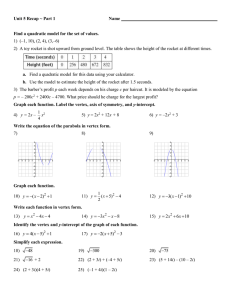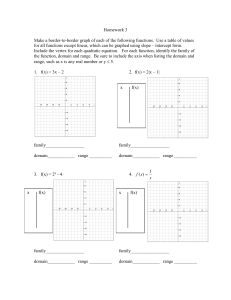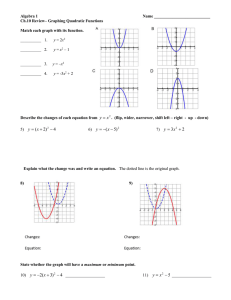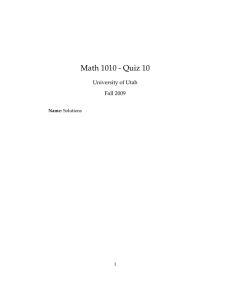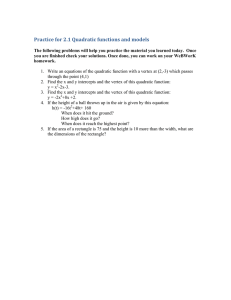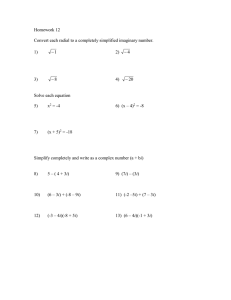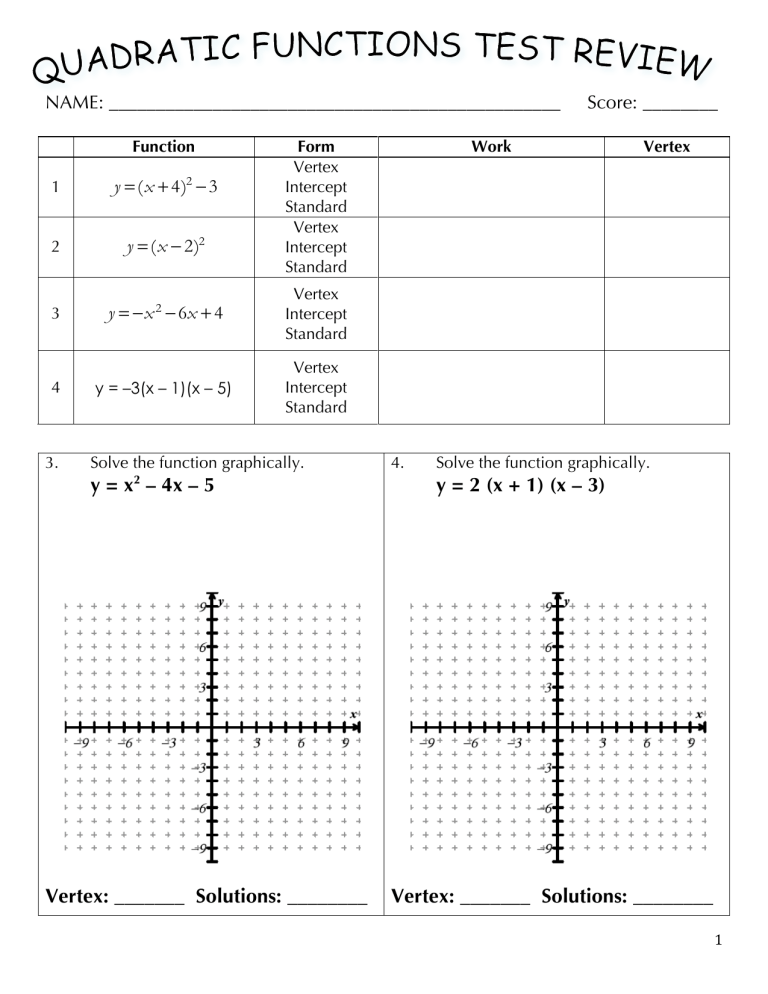
NAME: ________________________________________________ Function Form Vertex Intercept Standard Vertex Intercept Standard 1 y = (x + 4)2 − 3 2 y = (x − 2)2 3 y = −x − 6x + 4 Vertex Intercept Standard y = –3(x – 1)(x – 5) Vertex Intercept Standard 4 3. 2 Solve the function graphically. 2 y = x – 4x – 5 Vertex: _______ Solutions: ________ Score: ________ Work 4. Vertex Solve the function graphically. y = 2 (x + 1) (x – 3) Vertex: _______ Solutions: ________ 1 Section 1: Factoring Factor Completely! 1. x2 – 9x + 8 2. 3x2 – 48 3. 16x2 + 81 4. 100p2 – 49p 5. j2 – 10j + 21 6. 12x2 – 17x – 5 7. 24x2 – 14x – 5 8. 9x2 – 48x + 64 2 Section 2: Graph the Quadratic Equations 1. y = –(x + 3)2 + 4 2. y = x2 – 2x – 3 Vertex: _________________ Vertex: _________________ x - Intercepts: ____________ x - Intercepts: ____________ Axis of Symmetry: ________ Axis of Symmetry: _________ Y-intercept: ______________ Y-intercept: _______________ Domain: _____________________ Domain: _____________________ Range: _______________________ Range: _______________________ Increasing: ____________________ Increasing: ____________________ Decreasing: ___________________ Decreasing: ___________________ Maximum Value of function: _____ Maximum Value of function: _____ Minimum Value of function: _____ Minimum Value of function: _____ Solutions: ______________________ Solutions: ______________________ 3 3. y = –2x2 + 8 4. y = (x + 6) (x – 2) Vertex: _________________ Vertex: _________________ x - Intercepts: ____________ x - Intercepts: ____________ Axis of Symmetry: ________ Axis of Symmetry: _________ Y-intercept: ______________ Y-intercept: _______________ Domain: _____________________ Domain: _____________________ Range: _______________________ Range: _______________________ Increasing: ____________________ Increasing: ____________________ Decreasing: ___________________ Decreasing: ___________________ Maximum Value of function: _____ Maximum Value of function: _____ Minimum Value of function: _____ Minimum Value of function: _____ Solutions: ______________________ Solutions: ______________________ 4 Section 3: Exponents and Radicals Simplify. 1. 5a3 ⋅3a10 2. (−7x 3 ) 3. 16x5 y 2 6x5 y9 4. −2(evrthngisawsom )0 5. 10x −2 6. ⎛ 5 ⎞ ⎜ 2x ⎟ ⎝ ⎠ 7. x5 i x 3 1 2 8. 2 −3 x4 3 2 x Convert and evaluate. 9. 3 49 2 = Simplify. 11. − 48 13. 100x 16 y 17 −1 2 = 10. 125 12. (2 7 )(−5 3 ) 14. 16 2 5 15. 17. 5 28 + 3 7 3 5 Simplify. 19. 4 −27 16. ( 4 + 2 ) (7 − 3 5 ) 18. 1− 6 2+ 6 20. −25 − −49 21. 28x 5 y 20 22. (5 – i) – (–1 + 2i) + 6i 23. –3(5 – 4i) 24. (2 + 10i) (2 – 10i) 26. 2i − 4 5+ i Rationalize the denominator. 25. 3 6 − 2i 6 Section 4: Solve the Quadratic Equations Solve the quadratic equations. 1. x2 – 3 = 45 (sq. roots) 2. 4x2 – 25 = 0 3. 5. 7. 2x2 – 12x = 2x + 60 x2 + 14x = 3 x2 + 2x + 8 = 0 4. 2x2 – 5x – 12 (complete the square) 6. x2 – 4x + 1 = 0 (Quadratic Formula) 8. 2x2 – 4x = 30 (factor/ZPP) (sq. roots) (factor/ZPP) (complete the square) (Quadratic Formula) 7 Solve the quadratic equations (choose a method) 9. x2 – 11x + 18 = 0 10. 2(x + 3)2 + 10 = 50 11. 3x2 + x = 3 12. 4x2 + 25 = 0 13. 9x2 + 36x = 0 14. x2 + 20x + 104 = 0 15. 18x2 + 12x + 2 = 0 16. x2 + 17x + 200 = 13x – 43 8 Section 5: Systems 1. A system of equations is: ________________________________________________ 2. The solution(s) to a system is: ____________________________________________ Solve each system by graphing. If there is a solution, write it!! If the equations share infinite solutions, say so!! If they share no solutions, write No Solution. Check your work!!!! 3. y = –(x + 4)2 – 1 y = 3|x+4| – 5 Solution: ___________________ 4. x+y=4 y = –(x + 5)2 Solution: ___________________ Use substitution to find the solutions to the systems. Then CHECK with a calculator!! 5. y = x2 – 7x + 4 y=x–3 6. y = x2 – 5x + 10 y = 2x2 – 6x + 4 9 7. Which of the following are quadratic functions? (Circle all that apply) (a) () f x = 1 + 6x − 2 x2 (d) f ( x ) = −(x + 3)2 − 8 8. (b) f ( x ) = 2x 2 + 1 (c) f(x) = 5 – 3x (e) f ( x ) = −x − 4 (f) Find the discriminant and determine the number and type of solutions. y = 3x2 – 18x + 8 Discriminant: ________________ Number and Type of Solutions: ______________________ Convert to standard form (by multiplying). 9. y = (x + 4) (x – 3) 10. y = 2 (3x + 5) (x – 2) Convert to intercept form (by factoring). 11. y = x2 – 16x + 64 12. y = 2x2 – 3x – 20 Convert to vertex form (complete the square – refer to page 42 and 43). 13. y = x2 + 12x – 3 14. y = 2x2 – 20x + 1 10 1 2 3 4 5 6 7 8 9 10 11 12 13 14 15 QUESTION What is the form of the function: y = 2x2 + 3x + 2 What is the form of the function: y = 2(x + 3)2 – 10 What is the form of the function: y = – (x + 3) (x – 8) ANSWER A ANSWER B Intercept Form Standard Form Vertex Form Intercept Form Intercept Form Standard Form −b x= 2a ⎛b⎞ x =⎜ ⎟ ⎝ 2⎠ What formula will find the x-coordinate of the vertex for standard form? What formula will find the x-coordinate of the vertex for intercept form? What is the value of C that would complete the square: x2 – 4x + C x= x= p+q 2 4 16 1 2 A binomial sum of squares A trinomial Zero Product Property Complete the Square Square Roots Method Quadratic Formula Square Roots Method Complete the Square 2 Real 1 Real 2 Imaginary 2 Real 1 Real 2 Real 2nd Graph 2nd Calc What is the a-value: y = 2x2 + 5x + 2 What type of polynomial is always prime? What method would you use to solve the equation: y = (x + 3) (2x + 1) What method would you use to solve the equation: y = 4x2 + 10 What method would you use to solve the equation: y = x2 + 10x + 3 The discriminant is 24. How many and what type of solutions are there ? The discriminant is -10. How many and what type of solutions are there ? The discriminant is 0. How many and what type of solutions are there ? What calculator function can you use to find the vertex of a parabola? p−q 2 2 16 How do you find any x-intercept? Substitute 0 for x Substitute 0 for y 17 How do you find any y-intercept? Substitute 0 for x Substitute 0 for y 18 What is the quadratic formula? Find the y-intercept of each function: 19. y = 2x3 + 5x – 3 x= 20. −b b 2 − 4ac 2a x= −b ± b 2 − 4ac 2a y = 3 (x + 5) (2x – 1) 11
